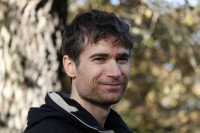CAZypedia celebrates the life of Senior Curator Emeritus Harry Gilbert, a true giant in the field, who passed away in September 2025.
CAZypedia needs your help!
We have many unassigned pages in need of Authors and Responsible Curators. See a page that's out-of-date and just needs a touch-up? - You are also welcome to become a CAZypedian. Here's how.
Scientists at all career stages, including students, are welcome to contribute.
Learn more about CAZypedia's misson here and in this article. Totally new to the CAZy classification? Read this first.
Difference between revisions of "User:Darrell Cockburn"
| Line 1: | Line 1: | ||
| − | |||
| − | |||
[[Image:Darrell1.jpg|200px|right]] | [[Image:Darrell1.jpg|200px|right]] | ||
Darrell Cockburn received his BSc. and PhD from the University of Guelph in Ontario, Canada. During his PhD under his adviser Anthony Clarke, Darrell primarily studied the structure function relationships within the endoglucanase family [[GH6]]. In 2010 Darrell moved to Denmark to take an H.C. Ørsted fellowship with Birte Svensson at the Technical University of Denmark. There he studied surface binding sites in a variety of carbohydrate active enzymes, with a particular focus on [[GH13]]. In 2013 Darrell moved to the University of Michigan to continue his Postdoctoral training with Nicole Koropatkin, studying the amylolytic systems of the gut bacteria ''Eubacterium rectale'' and ''Ruminococcus bromii''. | Darrell Cockburn received his BSc. and PhD from the University of Guelph in Ontario, Canada. During his PhD under his adviser Anthony Clarke, Darrell primarily studied the structure function relationships within the endoglucanase family [[GH6]]. In 2010 Darrell moved to Denmark to take an H.C. Ørsted fellowship with Birte Svensson at the Technical University of Denmark. There he studied surface binding sites in a variety of carbohydrate active enzymes, with a particular focus on [[GH13]]. In 2013 Darrell moved to the University of Michigan to continue his Postdoctoral training with Nicole Koropatkin, studying the amylolytic systems of the gut bacteria ''Eubacterium rectale'' and ''Ruminococcus bromii''. | ||
| − | |||
| − | |||
| − | |||
---- | ---- | ||
Revision as of 11:27, 16 October 2014
Darrell Cockburn received his BSc. and PhD from the University of Guelph in Ontario, Canada. During his PhD under his adviser Anthony Clarke, Darrell primarily studied the structure function relationships within the endoglucanase family GH6. In 2010 Darrell moved to Denmark to take an H.C. Ørsted fellowship with Birte Svensson at the Technical University of Denmark. There he studied surface binding sites in a variety of carbohydrate active enzymes, with a particular focus on GH13. In 2013 Darrell moved to the University of Michigan to continue his Postdoctoral training with Nicole Koropatkin, studying the amylolytic systems of the gut bacteria Eubacterium rectale and Ruminococcus bromii.
- Ruzanski C, Smirnova J, Rejzek M, Cockburn D, Pedersen HL, Pike M, Willats WG, Svensson B, Steup M, Ebenhöh O, Smith AM, and Field RA. (2013). A bacterial glucanotransferase can replace the complex maltose metabolism required for starch to sucrose conversion in leaves at night. J Biol Chem. 2013;288(40):28581-98. DOI:10.1074/jbc.M113.497867 |
- Cockburn DW and Clarke AJ. (2011). Modulating the pH-activity profile of cellulase A from Cellulomonas fimi by replacement of surface residues. Protein Eng Des Sel. 2011;24(5):429-37. DOI:10.1093/protein/gzr004 |
- Quirk A, Lipkowski J, Vandenende C, Cockburn D, Clarke AJ, Dutcher JR, and Roscoe SG. (2010). Direct visualization of the enzymatic digestion of a single fiber of native cellulose in an aqueous environment by atomic force microscopy. Langmuir. 2010;26(7):5007-13. DOI:10.1021/la9037028 |
- Cockburn DW, Vandenende C, and Clarke AJ. (2010). Modulating the pH-activity profile of cellulase by substitution: replacing the general base catalyst aspartate with cysteinesulfinate in cellulase A from Cellulomonas fimi. Biochemistry. 2010;49(9):2042-50. DOI:10.1021/bi1000596 |
- Jing H, Cockburn D, Zhang Q, and Clarke AJ. (2009). Production and purification of the isolated family 2a carbohydrate-binding module from Cellulomonas fimi. Protein Expr Purif. 2009;64(1):63-8. DOI:10.1016/j.pep.2008.10.015 |
- Legaree BA, Daniels K, Weadge JT, Cockburn D, and Clarke AJ. (2007). Function of penicillin-binding protein 2 in viability and morphology of Pseudomonas aeruginosa. J Antimicrob Chemother. 2007;59(3):411-24. DOI:10.1093/jac/dkl536 |
